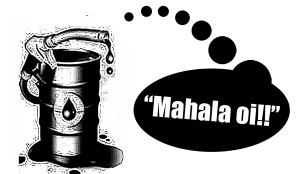BOHOL’S GAS PRICE PROBLEM
The P2-P5 discrepancy in gas prices in Bohol compared to other provinces will be likened to a mere migraine compared to a potential cancer problem if the Iran oil problem explodes.
The West had largely suspected that Iran-amid its domestic economic and political woes- is secretly developing “nuclear war” capabilities that will threaten world peace (sic). The United States (December 2011) and Europe (January 2012) thereby cut off Iran from the global financial system.
The problem is that Iran is the world’s third largest oil producer and has also threatened to blockade its Strait of Hormuz, the world’s most important transshipment point of oil. Once done, the world prices of oil will skyrocket to more than 50%, a catastrophe of unimaginable proportions.
The US threat of navy incursions and air strikes did not add anything to engender the peace even as an Iranian nuclear scientist was recently murdered- a case Tehran blamed at the doorsteps of Washington and her ally Israel.
The grimiest of prospects lie therein since the RP Government will not be able to do anything as we are under the regime of the Oil Deregulation Law RA 8499 (of 1998) under the Ramos regime.
The law was urgently passed then because the RP budget (amid the 1997 Asian crisis besides and the electric power shortage) was hamstrung and could no longer support the Oil Stabilization Fund which government used to offset international surge in oil cost and keep domestic oil prices stable.
Once the Iran crisis hits boiling point, forget any further growth in GDP and economic chaos will follow. Just dreading the thought make us sweat.
An IMF (International Monetary Fund) study earlier showed that for every US$5 dollar/barrel price increase in crude oil, the RP GDP will be reduced by o.8% (close to 1%) and inflation to scale up by 0.8% (close to 1%). Could one imagine much higher international oil prices hikes than that –considering prices at US$101/barrel already registered in the US oil free market?
The irony of it all is that the Deregulation Law, per admission of the DOE Regional Office, had resulted in reduced “returns” of local oil companies from 12% to 5% -yet from 1998 to 2008- in just 10 years- the price of gas in the streets has gone 500 percent. What then was the deregulation for?
The deregulation, at best, was meant to free the market from government interference in the hope that the free interplay of many players will bring down the market prices. Far from it.
Is there then an unwritten “cartelized pricing” among the Big Three- Petron, Shell and Caltex and is there a collusion even among “independent” players even after Governor Edgar Chatto convened a meeting to rationalize the exorbitant prices of gas in Bohol since last year?
In the deregulation law that empowers even the DOE ad the DTI to see that there is no “unfair trade practice” – it would seem that there is gap that is soooo wide in the regulatory law – “so wide, even a herd of elephants can pass through it.”
Lawyer-advocate Atty Victor de la Serna had warned last week that he will name names in the gallery of price-fixers and manipulators in the gas trade. That should be as welcome a valuable an information as the forthcoming explanation next week of the DOE as to why the prices in Bohol retail gas stations are higher than the other provinces.
Trans-shipment and sources of supply may also be valid reasons. For instance, if Siquijor gets its supply from Dumaguete, then Siquijor’s gas prices should naturally be higher than that of Dumaguete.
There is also the issue of the gap between the supply produced by the Luzon refineries and the country demand. The DOE says the RP refineries churn out 200,000 barrels a day versus the national demand of 300,000 barrels or causing a shortfall of 100,000 barrels that, therefore, have to be imported.
Davao, as reported, imports oil directly from Malaysia and Indonesia. If those two countries produce oil cheaper than our Luzon refineries and after computing the cost of shipment from them to Davao that would result in a cheaper “landed cost” in Davao compared to that coming from Luzon, it would not be surprising then if the Mindanao provinces who rely on cheaper imported oil will sell cheaper retail gas in their stations compared to those relying on the Luzon refineries.
These is mere speculation and only a categorical and logical explanation from the DOE will solve the riddle that had bedeviled many who are studying the gas price phenomenon in Bohol. The DOE has suggested that attracting more independent-players and retailers (20 was their magic number) will make the threat of price manipulation and cartelization a mere distant possibility. Well and good- but that is not the big picture, yet.
While we are at that, pray that Iran and her Shah will not lose their cool and throw a plague to the world with murder in their eyes. This is because the RP government, by then, cannot afford the logistics and the money to execute a “rationing” program of oil-they way it was possible many years ago when the oil industry was still regulated.
It will be to each man his own. We have to double our rosary prayers.
Check for PRC Board Exam results at PRCPassers.com


No Comments to “BOHOL’S GAS PRICE PROBLEM”
add a comment.